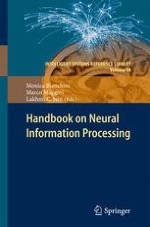2013 | OriginalPaper | Chapter
Self Organisation and Modal Learning: Algorithms and Applications
Authors : Dominic Palmer-Brown, Chrisina Jayne
Published in: Handbook on Neural Information Processing
Publisher: Springer Berlin Heidelberg
Activate our intelligent search to find suitable subject content or patents.
Select sections of text to find matching patents with Artificial Intelligence. powered by
Select sections of text to find additional relevant content using AI-assisted search. powered by
Modal learning in neural computing [33] refers to the strategic combination of modes of adaptation and learning within a single artificial neural network structure. Modes, in this context, are learning methods that are transferable from one learning architecture to another, such as weight update equations. In modal learning two or more modes may proceed in parallel in different parts of the neural computing structure (layers and neurons), or they occupy the same part of the structure, and there is a mechanism for allowing the neural network to switch between modes.
From a theoretical perspective any individual mode has inherent limitations because it is trying to optimise a particular objective function. Since we cannot in general know a priori the most effective learning method or combination of methods for solving a given problem, we should equip the system (the neural network) with the means to discover the optimal combination of learning modes during the learning process. There is potential to furnish a neural system with numerous modes. Most of the work conducted so far concentrates on the effectiveness of two to four modes. The modal learning approach applies equally to supervised and unsupervised (including self organisational) methods. In this chapter, we focus on modal self organisation.
Examples of modal learning methods include the Snap-Drift Neural Network (SDNN) [5, 25, 28, 33, 32] which toggles its learning between two modes, an adaptive function neural network, in which adaptation applies simultaneously to both the weights and to the shape of the individual neuron activation functions, and the combination of four learning modes, in the form of Snap-drift ADaptive FUnction Neural Network [17, 18, 33]. In this chapter, after reviewing modal learning in general, we present some examples methods of modal self organisation. Self organisation is taken in the broadest context to include unsupervised methods.We review the simple unsupervised modalmethod called snap-drift [5, 25, 28, 32], which combines Learning Vector Quantization [21, 22, 23, 37] with a ’Min’ or Fuzzy AND method. Snap-drift is then applied to the Self-Organising Map [34]. The methods are utilised in numerous real-world problems such as grouping learners’ responses to multiple choice questions, natural language phrase recognition and pattern classification on well known datasets. Algorithms, dataset descriptions, pseudocode and Matlab code are presented.
